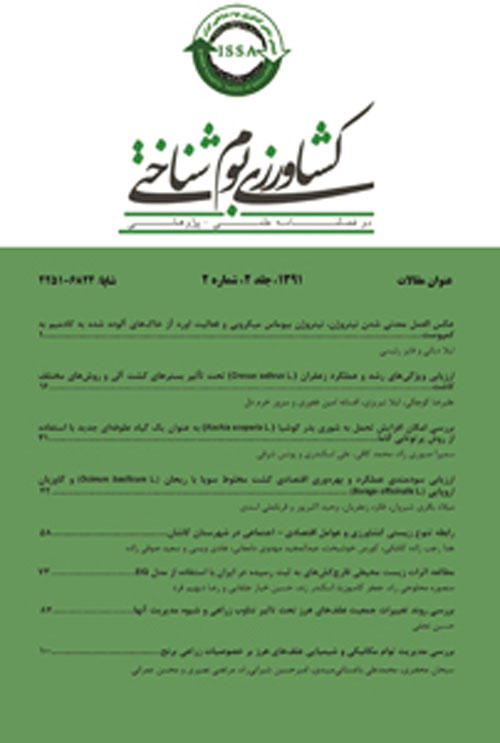Alignment of regional management maize production and climate change in Iran (spatial panel approach)
Author(s):
Abstract:
Introduction
Climate change and its diversity is one of the greatest challenges which will face humanity in this and future centuries and the economic effects of climate change on agriculture have been a concern for policymakers. The effect of climate change on the agricultural sector has been largely harmful: For example, the effects of periodic droughts and floods have always threatened the life of rural populations that depend on agriculture (Ranganathan et al., 2010). According to FAO (2014), an important part of the maize supply in Iran is provided through importation and one of the main reasons for the increase in maize imports over recent years is a decrease in its yield that depends on climatic conditions. Through improvement of domestic production essential steps can be taken towards self-sufficiency in production of this product (Kazemnejad and Gilanpour, 2014). Given that maize is one of the basic agricultural products and considering its importance and strategic role, a survey of the factors affecting production of this product and, in particular, the effect of climatic factors is necessary. So, in this paper the alignment of regional management of maize production and climate change was studied using a spatial model and panel data for 15 provinces during the period 1984-2010.Material and
Methods
In this research, a spatial econometric approach was used to study the effect of climatic factors on maize production and, due to the type of available data, a panel data approach has been used. Panel data provides a suitable environment for the development of estimation methods and researchers were able to use cross sectional and time series data to discuss issues that it is not possible to study through time series or cross section data alone (Baltagi, 2005). Climatic variables used in this study included the planting temperature, growth temperature, harvest temperature, planting precipitation and growth precipitation of product.Results And Discussion
Results of the Moran test for presence of spatial effects in the panel data showed that there is spatial autocorrelation in the data and the spatial autocorrelation coefficient between the provinces is 0.47. This shows that, in order to survey effect of climatic factors on maize production, we need to consider the geographical situation and vicinity in the model. Estimation of the random effect spatial model (derived from a modified Hausman test) in surveying the impact of climate change on maize production showed that the increase in planting temperature has a negative effect on maize production while the square of planting temperature has positive effect on maize production. Also, harvest temperature has a positive effect on maize production and the square of harvest temperature has negative effect on maize production. Planting precipitation has negative effect and growth temperature has positive effect on maize production; also, the effect of the area under cultivation is positive.Conclusion
According to the findings, it is advisable to avoid delaying maize planting in warm places such as Khozestan, Isfahan, Ilam, Yazd, Hormozgan and Semnan or, if it is possible, to use heat resistant maize seeds. In areas where the maize harvest is grown in winter, accelerating the harvest under warmer conditions leads to an increase in production. Moreover, it is better to plant maize in Kurdistan and Ghazvin provinces with little delay which is not affected by extreme rainfall of early spring. In Kurdistan, Lorestan and Ilam provinces that have high growth precipitation, it's better for farmers to be insured against systemic risk. Keywords:
Language:
Persian
Published:
Journal of Agroecology, Volume:6 Issue: 2, 2017
Page:
74
magiran.com/p1680986
دانلود و مطالعه متن این مقاله با یکی از روشهای زیر امکان پذیر است:
اشتراک شخصی
با عضویت و پرداخت آنلاین حق اشتراک یکساله به مبلغ 1,390,000ريال میتوانید 70 عنوان مطلب دانلود کنید!
اشتراک سازمانی
به کتابخانه دانشگاه یا محل کار خود پیشنهاد کنید تا اشتراک سازمانی این پایگاه را برای دسترسی نامحدود همه کاربران به متن مطالب تهیه نمایند!
توجه!
- حق عضویت دریافتی صرف حمایت از نشریات عضو و نگهداری، تکمیل و توسعه مگیران میشود.
- پرداخت حق اشتراک و دانلود مقالات اجازه بازنشر آن در سایر رسانههای چاپی و دیجیتال را به کاربر نمیدهد.
In order to view content subscription is required
Personal subscription
Subscribe magiran.com for 70 € euros via PayPal and download 70 articles during a year.
Organization subscription
Please contact us to subscribe your university or library for unlimited access!



